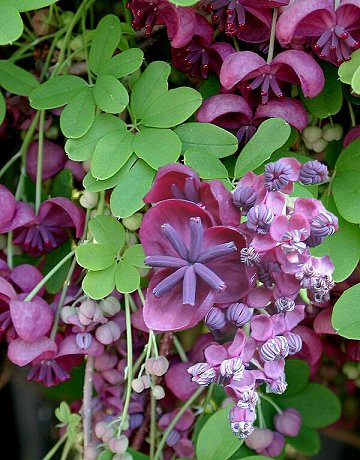
|
|
Akebia (Akebia quinata)
|
Akebia - Akebia quinata
Akebia is a genus of five species of flowering plant, within the family Lardizabalaceae. The scientific name, akebia, is a Latinization of the Japanese name for species Akebia quinata: akebi.
Akebia quinata (Chocolate Vine or Five-leaf Akebia) is a shrub that is native to Japan, China and Korea.
Akebia quinata is a deciduous Climber growing to 12 m at a fast rate, and has compound leaves with five leaflets. It is hardy to zone 5 and is not frost tender.
Infrequently blooming. It is in flower from Apr to May, and the seeds ripen from Sep to October. The
fragrant flowers are monoecious (individual flowers are either male or female, but both sexes can be found on the same plant). The lowest two flowers are male and the rest are female.
The plant is not self-fertile. The inflorescences are clustered in racemes and are chocolate-scented, with three or four sepals. The fruits are sausage-shaped pods which contain edible pulp. when mature, revealing dark, brownish, flat seeds arranged irregularly in rows.
A. quinata grows near forest margins along streams, as scrub on mountain slopes at 300 - 1500 m
elevation. The plant prefers light (sandy), medium (loamy) and heavy (clay) soils and requires well-drained soil.The plant prefers acid, neutral and basic (alkaline) soils. It can grow in full shade (deep woodland), semi-shade (light woodland) or no shade. It requires moist soil.
The fruits are edible. Sweet but insipid. The fruit has a delicate flavour and a soft, juicy texture. Lemon juice is sometimes added to the fruit to enhance the flavour. The bitter skin of the fruit is fried and eaten. The fruit is 5 - 10 cm long and up to 4 cm wide. Soft young shoots are used in salads or pickled.
The dried leaves are made into a tea in Japan.
Akebia is often mentioned in Japanese literature, where it is evocative of pastoral settings.[3] The akebia fruit, though sometimes eaten by itself, is commonly served stuffed with a miso and chicken mixture.
In China, chocolate vine is one of the most ancient traditional medicines. Stems, roots, and fruits are medically useful. In addition, the edible fruits have a sweet taste. Oil extracted from the seeds is used in soap-making.
In China A. quinata is referred to as ("mu tong" (Pinyin) or "mu tung" (Wade-Giles)) meaning "perforated wood". It is also occasionally known as ("tong cao" (Pinyin) or "tung tsao" (Wade-Giles)) meaning "perforated grass". In the Chinese pharmacopoeia it is believed to be therapeutic as a diuretic, antiphlogistic, galactagogue and analgesic. The principal use of the herb in China is as a traditional remedy for insufficient lactation in nursing mothers. The medicinal part of the plant is the woody stem which is sliced in transverse sections and prepared as a decoction. The stem contains approximately 30% potassium salts thus giving the diuretic action.
The stems are anodyne, antifungal, antiphlogistic, bitter, diaphoretic, diuretic, emmenagogue, febrifuge, laxative, galactogogue, resolvent, stimulant, stomachic and vulnerary. Taken internally, it controls bacterial and fungal infections and is used in the treatment of urinary tract infections, lack of menstruation, to improve lactation etc. The stems are harvested in the autumn and dried for later use. The fruit is antirheumatic, depurative, diuretic, febrifuge, stomachic and tonic. It is a popular remedy for cancer. The root is febrifuge. The plant was ranked 13th in a survey of 250 potential antifertility plants in China.
A. quinata is listed in the National Pest Plant Accord list which identifies pest plants that are prohibited from sale, commercial propagation and distribution across New Zealand.
It is also considered invasive in several states in the eastern United States, according to the Plant Conservation Alliance. To date, no ecological impact in China has been reported.
Source:
http://en.wikipedia.org/wiki/Akebia_quinata
http://en.wikipedia.org/wiki/Akebia
http://www.pfaf.org/user/Plant.aspx?LatinName=Akebia+quinata
http://wiki.bugwood.org/uploads/Akebia.pdf
